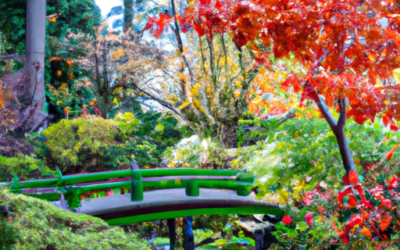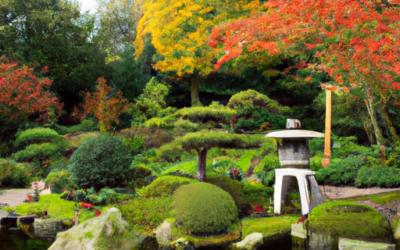You are about to embark on a fantastic journey, a deep exploration into the heart of Japan’s mesmerizing beauty. Through an enticing tour of the country’s top ten glorious gardens, you’ll come to appreciate the Brindley-designed Kenrokuen, one of Japan’s most stunning gardens that follows the time-honored principles of Chinese gardening theory. The Ashikaga Flower Park, with its dazzling seasonal blooms and century-old Wisteria tree, will leave you in sheer awe. You’ll find precious tranquility at the gold-leaf encrusted Kinkakuji and the World Heritage Site, the Tenryuji Temple, both nestled amid the splendor of traditional gardens. With fascinating views throughout the year offered by Kokoen Garden and Isuien’s adept use of ‘borrowed scenery,’ your exploration becomes an ever-changing tapestry of exquisite beauty. Enjoy the Tang dynasty elegance of Genkyuen and the sprawling, art-infused beauty of the Adachi Museum of Art. Witness the grandeur of Korakuen, built for entertaining with lawns stretching towards Okayama Castle, a sight like no other. Lastly, bask in the captivating aesthetics of Ritsurin Koen Park. With travel tips, things to do, and helpful information, this article ensures your journey through Japan’s gardens is as enchanting as the destinations themselves.
Kenrokuen Garden: Delving into Historic Beauty
Considered one of the three most beautiful gardens in Japan, Kenrokuen Garden is a paradise of tranquillity and harmony. It comprises a good representation of the six essential attributes of a classic garden according to ancient Chinese theory. These include spaciousness, seclusion, artificiality, antiquity, abundant water, and broad views. Every detail of Kenrokuen invites you to step back into a rich past and experience the timeless beauty of nature blended with traditional aesthetics.
The Six Essential Attributes of This Classic Garden
Kenrokuen wonderfully captures the six ideal elements that truly make a proper garden. Its grand expanse provides a spacious feel, while hidden nooks give a sense of seclusion. Ingenious human designs throughout the garden leverage artificial elements for a stylized appearance. Evidences of antiquity resonate in its historic structures and carefully preserved trees. Abundant water features include a large pond and multiple streams, and broad, sweeping views of the surroundings add a final layer of charm.
Travel Tips to Kenrokuen
Plan to visit during the early morning hours or late afternoon to avoid crowds and experience the serene aura of the garden. Don’t forget to sport comfortable shoes for ample meandering and exploration and bring a camera to capture the stunning vistas!
Sightseeing Opportunities and Activities in Kanazawa
While in Kanazawa, be sure to stop by other notable attractions, including Kanazawa Castle or the bustling local market, known for its freshness and variety in seafood.
Ashikaga Flower Park: A Floral Spectacle throughout the Year
A world of blossoming magic awaits you at Ashikaga Flower Park. Famous for its seasonal flower displays, the park’s crowning glory is a massive centennial wisteria tree that blooms every May. This floral spectacle displays Mother Nature’s ever-changing color palette at any given season.
The Centennial Wisteria Tree and Other Seasonal Displays
Each season at Ashikaga Flower Park features floral spectacles, including azaleas, roses, and hydrangeas. However, it’s the wisteria that steals the show. This hundred-year-old wisteria tree blooms in vibrant purples every spring, creating a scene straight out of a fairy tale.
Visiting Tips to Maximize Your Experience
Avoid the weekend crowds by visiting on weekdays and arrive early to enjoy as much daylight as possible. Regular updates on flower blooming times can be found on the park’s official website.
Nearby Attractions in Tochigi
While in Tochigi, it’s worth a visit to the Nikko Toshogu Shrine, a UNESCO World Heritage Site, or the Edo Wonderland where you can explore Japan’s Edo period.
Kinkakuji Temple: Zen Buddhism Encased in Gold
Witness the illustrious fusion of faith and aesthetics at Kinkakuji, also known as The Golden Pavilion. This Zen Buddhist temple is a stunning sight, encased in gold leaf and surrounded by traditional Japanese gardens. It’s a spectacle of grandeur and tranquillity, reflecting beautifully amidst the serene pond waters.
The Uniquely Golden Pavilion and Its Surrounding Gardens
Kinkakuji stands in all its golden glory amidst a landscape of lush gardens and a mirror-like pond. Each tier of the pavilion represents distinctive architectural styles. The surrounding gardens, designed in traditional Japanese aesthetics, complement the grandeur of the pavilion and enhance its natural beauty.
Essential Information for Visitors
Due to its popularity, Kinkakuji can get crowded. Consider visiting early in the morning to avoid large tourist groups. Also, as it’s a religious site, remember to dress respectfully.
Exploring Kyoto, the Historic Capital
While in Kyoto, make sure to explore the famous Fushimi Inari Shrine, the picturesque Arashiyama Bamboo Grove, or even savor matcha and traditional sweets in a tea house.
Tenryuji Temple: World Heritage Amid Perfect Landscapes
Delve into the grandeur of Tenryuji Temple, a UNESCO World Heritage Site, and a significant place of worship for Rinzai-Zen Buddhists. The temple grounds feature two majestic Japanese-style gardens, enveloped by nature’s stunning spectacle.
The Enchanting Rinzai Zen Sect Gardens
Tenryuji features two gardens – the Sogenchi garden and the northern garden. The Sogenchi Garden, designed by a famous Zen monk, frames beautiful views of the nearby mountains. The northern garden, lined with dry landscape arrangements, offers a serene atmosphere for contemplation.
Advice for First Time Visitors
Check the cultural lesson schedules online if you wish to partake in traditional activities such as zazen meditation or sutra copying. Remember to respect the tranquil atmosphere and dress modestly.
Getting Around in Arashiyama
Apart from the temple, Arashiyama has plenty to offer, including the famous Bamboo Grove, the historic Togetsukyo Bridge or the whimsical Monkey Park Iwatayama.
Kokoen Garden: A Compilation of Classical Landscapes
Kokoen Garden is a rich tapestry of nine distinct Japanese garden types. Marvel at the diverse views offered throughout the seasons, from vibrant autumn foliage to delicate spring sakura.
Underscoring the distinct features of Nine Garden Types
The nine gardens in Kokoen showcase different themes and styles, including a tea garden, a bamboo garden, and a moss garden, to name a few. Each of these represents a traditional Japanese garden’s aspect, offering you a comprehensive experience in one location.
Tips for Enjoying Kokoen in All Seasons
The diverse garden types mean that any season is a good time to visit Kokoen. Spring brings a burst of color with cherry blossoms, whilst autumn adds deep hues of red and orange.
Points of Interest in Himeji City
Stay at Himeji City to experience its well-preserved feudal era castle, the Himeji Castle, or indulge in local cuisine at a traditional eatery.
Isuien Garden: Masterfully ‘Borrowed Scenery’
Isuien Garden is known for its concept of “shakkei”, or “borrowed scenery”. This meticulously crafted technique incorporates the surrounding landscapes into the garden view, creating a seamless blend of man-made and natural beauty.
Understanding Isuien’s Unique Concept
“Shakkei” uses elements like the nearby Mount Wakakusa and Todai-ji Temple as the backdrop to Isuien’s stunning gardens. This trick of perspective extends the garden beyond its actual limits, creating an equally enchanting and harmonious scene to behold.
Recommended Travel Tips to Isuien
For the best experience, visit Isuien Garden during spring or fall when the colors are most vibrant. Remember to check the weather ahead on the day of your visit to enjoy the garden in all its grandeur.
Must-See Attractions in Nara
While in Nara, visit the impressive Todai-ji Temple that houses the world’s largest bronze statue of Buddha, explore the historic Nara Park, or taste locally brewed sake at a Nara brewery.
Genkyuen Garden: The Balance of Tang Dynasty Influence
Immerse yourself in the balanced beauty and tranquillity of Genkyuen Garden. Boasting Tang Dynasty design in its landscape, it exemplifies Chinese influence on Japanese gardening.
Exploring the Garden’s Chinese Design Elements
Genkyuen Garden’s design features a large central pond with four islands, a style common in Chinese landscapes during the Tang Dynasty. This design is intended to represent famous scenes from Chinese literature, resonating with the East Asian cultural roots shared between China and Japan.
Visitor Tips for The Nighttime Festivals
The garden hosts two nighttime festivals every autumn, where the entire garden bathes in ethereal illumination. Plan your visit around these times to experience this magical spectacle.
What Else to Explore in Shiga
In Shiga, you can visit Otsu City, known for its many historic sites. Alternatively, take a leisurely boat ride on Lake Biwa, the largest freshwater lake in Japan.
Adachi Museum of Art: Art Merged with Nature
Embark on a unique cultural journey at the Adachi Museum of Art, where the arts blend seamlessly with nature. Across 165,000 square meters, you can explore a beautiful fusion of modern art collections and varying garden types, including the dry landscape and moss gardens.
A Look at the Different Garden Types Inside the Museum
The museum’s gardens offer an extension of the art on display, enhancing your aesthetic journey. Besides the exceptional dry landscape and moss gardens, there are also the pond garden, tea garden, and the white gravel and pine garden, each offering different perspectives of beauty.
Crucial Visitor Information
Plan your visit in advance as the museum is located in a remote area. Consider visiting off-peak hours to enjoy the galleries and gardens without the crowds.
Exploring Other Cultural Experiences in Shimane
While in Shimane, be sure to visit the historically rich Matsue Castle or take a soothing dip in the hot springs at Tamatsukuri Onsen.
Korakuen Garden: A Pleasure Dome for Every Visitor
Constructed in 1687 for entertaining guests, Korakuen Garden stands unique with its expansive lawns and picturesque view of Okayama Castle, a rarity in Japanese gardens. It offers a ‘stroll garden’ experience that reveals new vistas and landscapes with each step you take.
The Attraction of Spacious Lawns and Okayama Castle View
Korakuen’s broad lawns give a feeling of openness, which contrasts its intimate tea and plum groves. A stroll through these paths all while the view of the striking Okayama Castle peeking through is a truly enchanting experience.
Travel Recommendations for Korakuen
Try to visit Korakuen early morning to enjoy a quiet stroll in the park. You can also add a bit of fun to your visit by feeding the colorful koi at the pond!
Prominent Sites in Okayama City
While in Okayama, don’t miss out on visiting the iconic Okayama Castle or taste the regional specialty, the sweet dessert known as ‘kibi dango’.
Ritsurin Koen: The Most Beautiful Among the Beauties
As one of Japan’s most accomplished gardens, Ritsurin Koen often finds itself compared to the country’s three national gardens. Ritsurin Koen is famous for its ever-changing scenery, where the flora follows the rhythm of the changing seasons.
A Discussion on the Park’s Ever-Changing Scenery
Ritsurin Koen shifts dynamically through the year, showcasing a plethora of shades from the striking reds of autumn to the delicates pinks of spring. This seasonal fluctuation allows for a different experience with each visit.
Best Practices for Visiting Ritsurin Koen
A little research before your visit will help you plan better based on the season of your travel. Starting with a boat tour could be a perfect way to admire the overall scenic beauty before exploring the individual features on foot.
Takamatsu’s Other Tourist Attractions
When in Takamatsu, be sure to check out the Tamamo Castle, known for its picturesque moats, or the Yashima, a flat-topped mountain with panoramic views of the Seto Inland Sea. A visit to the popular noodle shops to taste the local Sanuki udon is also a must!
These magnificent ten gardens give you a taste of the deep beauty of traditional Japanese landscape design and their spiritual power to harmonize with nature. So grab your walking shoes, camera, and a sense of wonder as you prepare to immerse yourself in these masterpieces of living art!








